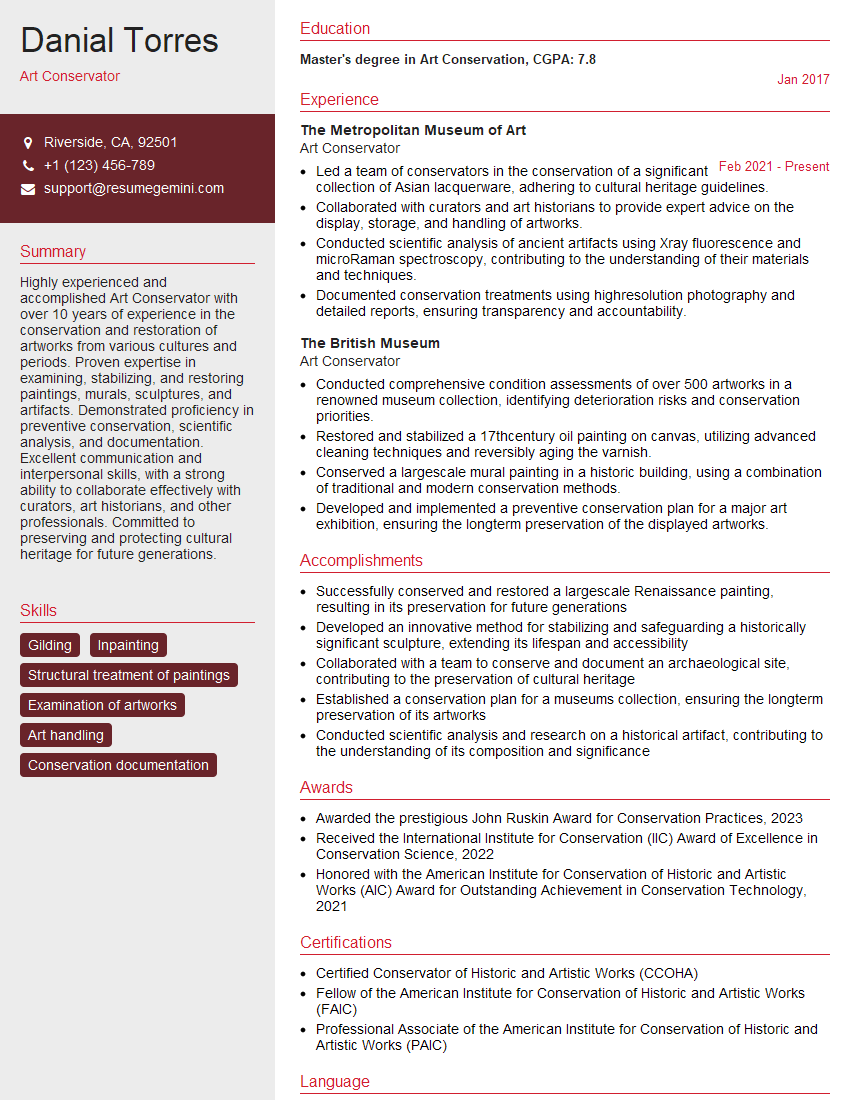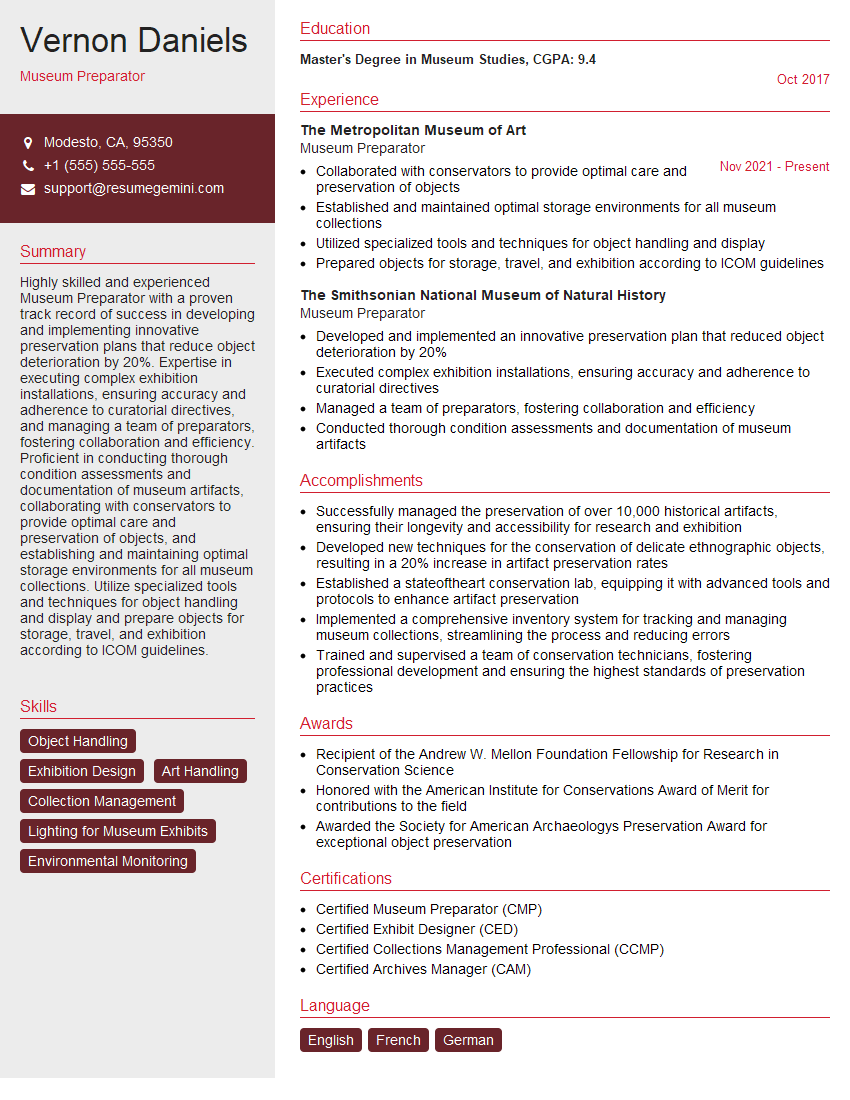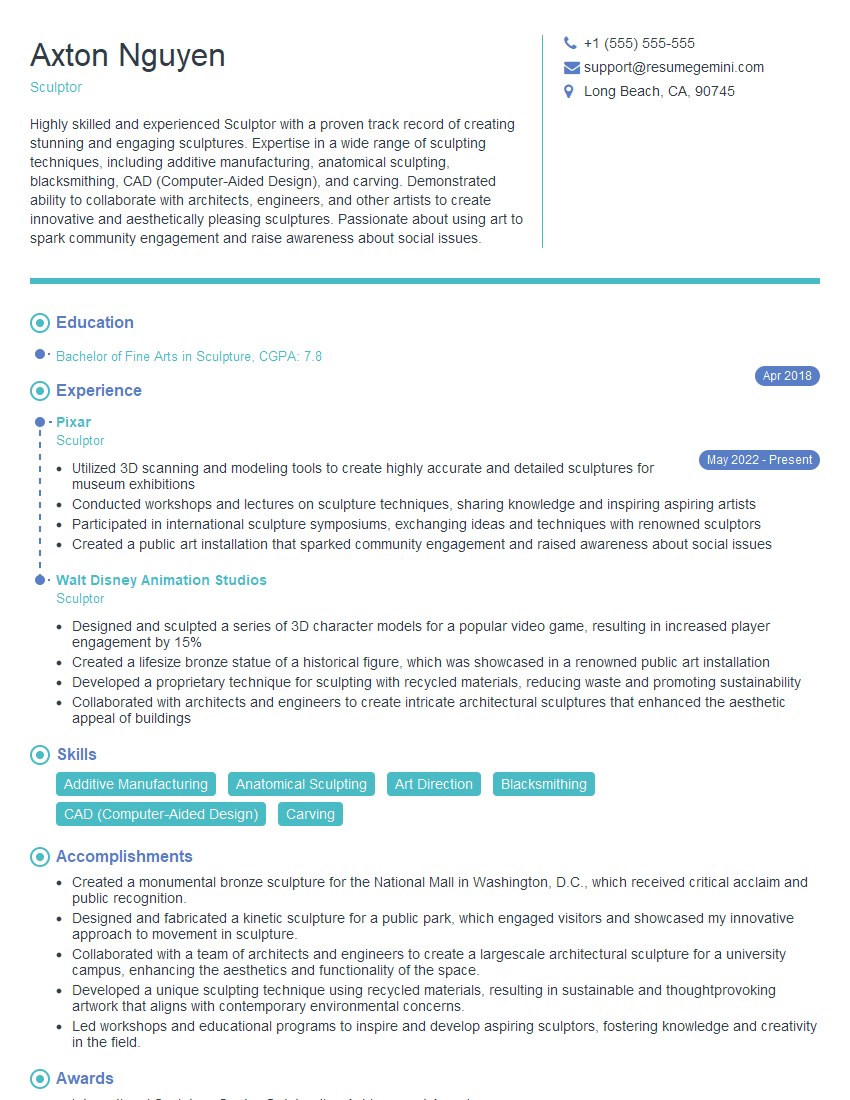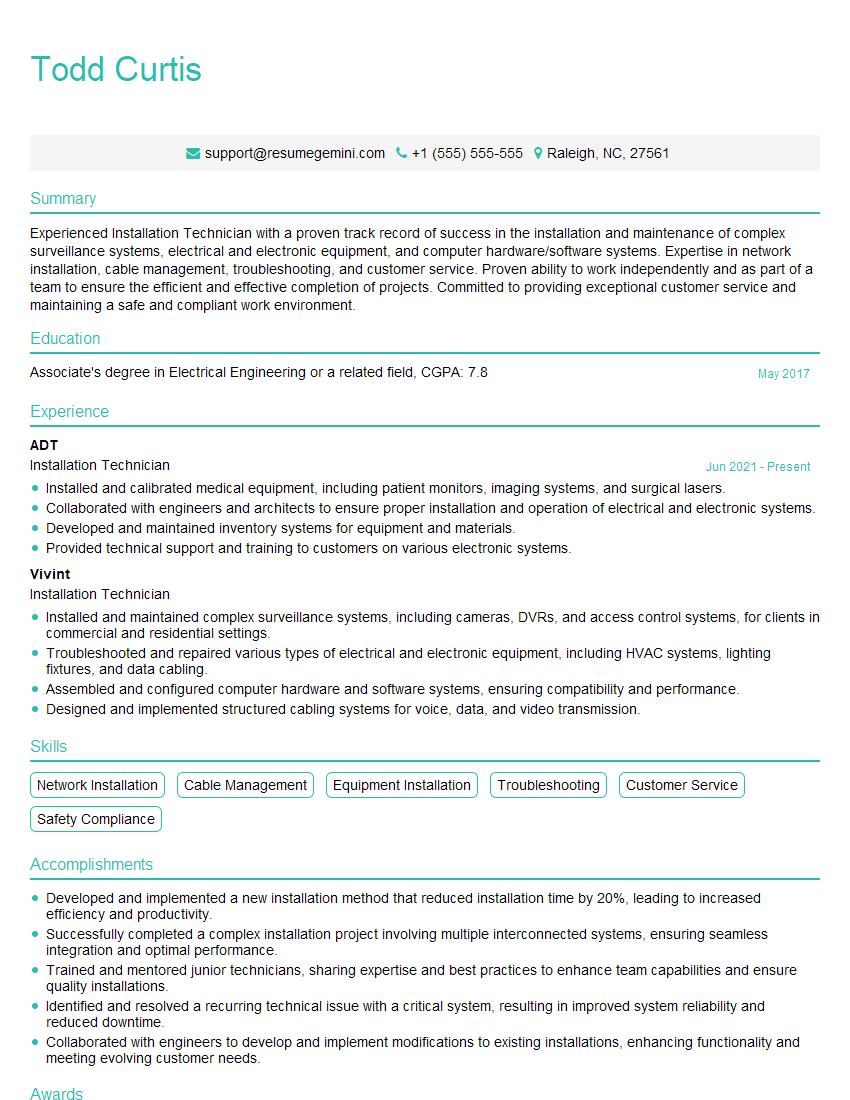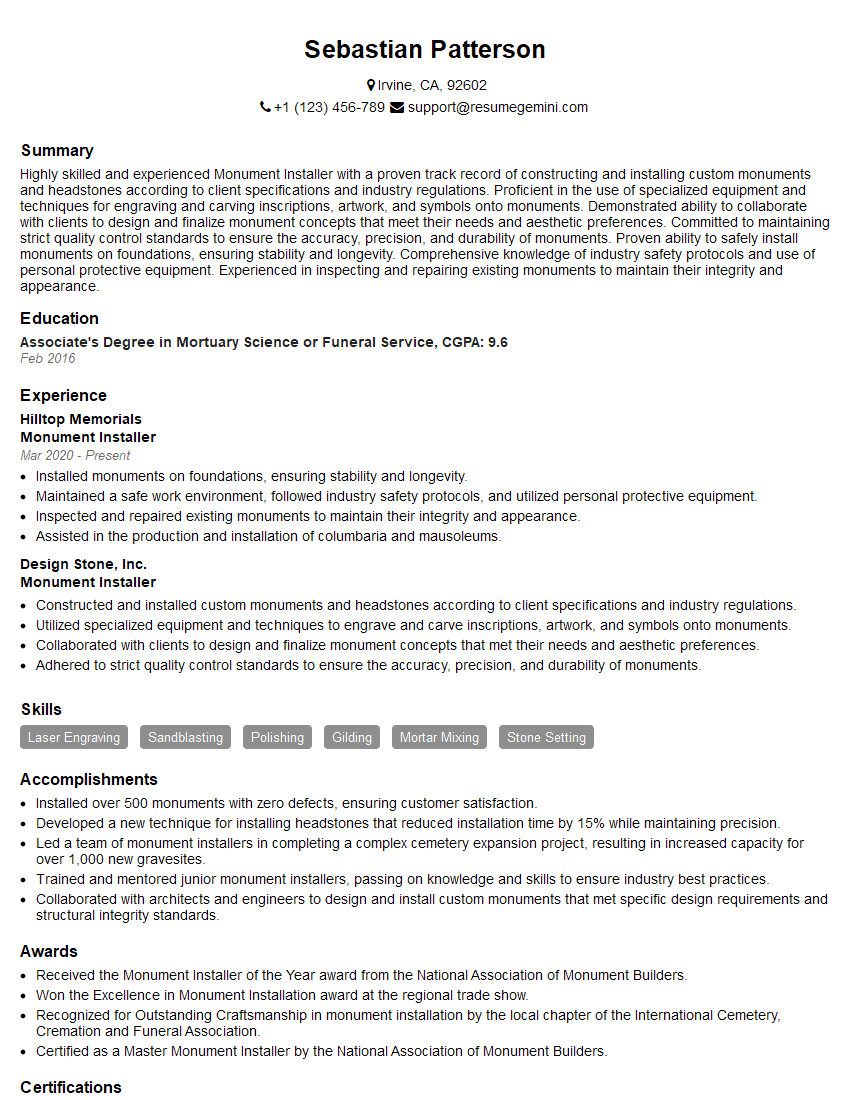The right preparation can turn an interview into an opportunity to showcase your expertise. This guide to Concrete Sculpture Installation interview questions is your ultimate resource, providing key insights and tips to help you ace your responses and stand out as a top candidate.
Questions Asked in Concrete Sculpture Installation Interview
Q 1. Describe your experience with different concrete mixes and their suitability for sculptures.
Choosing the right concrete mix is crucial for a successful concrete sculpture. The ideal mix depends on the desired aesthetic, the sculpture’s size and complexity, and the environmental conditions. I’ve worked with a wide variety of mixes, from high-strength mixes for large, freestanding pieces to mixes incorporating lightweight aggregates for sculptures designed to minimize stress on their supports. For example, a highly detailed, intricate sculpture might benefit from a finer, more workable mix, allowing for precise detail. Conversely, a massive, robust piece might require a high-strength mix with a lower water-cement ratio for increased durability and resistance to cracking. I often experiment with different admixtures – substances added to modify the concrete’s properties. For instance, air-entraining admixtures improve freeze-thaw resistance, crucial for outdoor installations. Understanding the interplay between cement type, aggregate size and type, water content, and admixtures is key to achieving the desired result. A poorly chosen mix can lead to cracking, fragility, or an undesirable surface finish.
Q 2. Explain the process of preparing a site for concrete sculpture installation.
Site preparation for a concrete sculpture installation is as critical as the sculpture itself. It involves a thorough assessment of the location, considering factors such as ground stability, drainage, and accessibility. For a large sculpture, a firm, level foundation is paramount. This often involves excavating, compacting the soil, and possibly adding a reinforced concrete base. Smaller sculptures may only need a leveled and compacted area. Drainage is crucial to prevent water buildup around the base, which can cause cracking or erosion. Ensuring adequate access for transportation and lifting equipment is also vital. Finally, environmental factors are assessed; strong winds or harsh weather conditions might necessitate additional protection or adjustments to the installation plan. For example, I once installed a large abstract piece near the coast and had to reinforce the base to withstand potential wind stress and salt spray.
Q 3. What safety precautions do you take during concrete sculpture installation?
Safety is paramount throughout the installation process. Personal Protective Equipment (PPE) is mandatory, including hard hats, safety glasses, gloves, and steel-toed boots. We always follow strict lifting procedures for heavy components, utilizing appropriate lifting equipment like cranes and forklifts, with trained operators and spotters ensuring a safe lift. We use barriers and signage to control access to the work area, preventing accidental contact with the sculpture or equipment. Working at heights requires additional precautions like scaffolding and harnesses. The potential hazards of concrete work, such as chemical burns from cement and respiratory issues from dust, are mitigated with appropriate protective measures. Proper training and communication among the team are essential in minimizing risks. We always adhere to local safety regulations and conduct regular safety briefings.
Q 4. How do you handle the transportation and lifting of large concrete sculptures?
Transporting and lifting large concrete sculptures requires meticulous planning and specialized equipment. For sculptures that are too large for a single piece, they are often cast in sections on-site or in a workshop that can accommodate the piece and transported individually. For large monolithic pieces, specialized lowboy trailers and heavy-lift cranes are used. The sculpture needs to be carefully secured to the trailer or lifting gear using appropriate straps and padding to prevent damage during transit. The lifting process is carefully choreographed, with multiple spotters to guide the crane operator and ensure the sculpture is lifted and positioned safely and precisely. I’ve had experiences where complex rigging systems, including custom slings and spreader beams, are used to handle oddly shaped pieces or those with delicate elements. Precise planning, including detailed weight calculations and consideration of ground bearing capacity, are absolutely essential to the success of the transport and lifting operation.
Q 5. Describe your experience with various anchoring and fastening techniques for concrete sculptures.
Anchoring and fastening techniques vary greatly depending on the sculpture’s size, weight, material, and the site conditions. For smaller sculptures, robust epoxy adhesives or mechanical fasteners like bolts and threaded rods can be used. Larger sculptures often require more substantial anchoring systems, such as deep foundation piles, base plates secured to the ground with anchor bolts, or even specialized structural support systems integrated into the sculpture’s design. The choice depends on the soil conditions and the potential for movement or stress on the sculpture. In certain cases, especially with delicate or intricate works, I might use a combination of methods to ensure secure and stable installation. For instance, I might use chemical anchors to secure a base plate and then use mechanical fasteners to attach the sculpture itself to the base. Thorough inspections and calculations are vital to ensure the anchorage system is up to the task.
Q 6. How do you ensure the structural integrity of a concrete sculpture during installation?
Ensuring structural integrity is a top priority. This begins during the design phase, where we calculate stresses, analyze potential weak points, and incorporate reinforcement as needed. During installation, we carefully monitor the placement and alignment of the sculpture to minimize stress and prevent cracks or damage. This often involves using precision leveling equipment and ensuring that the foundation or base is perfectly level and stable. For larger pieces, structural engineers might be consulted to analyze the load-bearing capacity of the foundation and the sculpture itself, ensuring it can withstand environmental forces like wind and seismic activity. Post-installation inspections are crucial to detect any settling or signs of stress, allowing for timely intervention to prevent further problems.
Q 7. What are your methods for protecting a concrete sculpture during transport and installation?
Protecting the sculpture during transport and installation is crucial to prevent damage. We use specialized protective materials such as heavy-duty blankets, foam padding, and custom-made crates to cushion the sculpture against impacts and vibrations during transport. The sculpture is often wrapped in layers of protective material and secured within the crate or on the trailer to prevent shifting. During installation, we utilize appropriate rigging and lifting gear to prevent damage to delicate surfaces. Temporary protective coverings might be used to shield the sculpture from the elements, especially if the installation takes place over several days. The process of removal of protective materials after installation must be carefully controlled to prevent accidental scratches or damage. In essence, every stage, from initial packaging to final placement, demands careful handling to preserve the integrity of the artwork.
Q 8. How do you deal with unexpected challenges during installation, such as damaged pieces or site issues?
Unexpected challenges are inherent in large-scale art installations. My approach is proactive and multi-faceted. For damaged pieces, I first assess the extent of the damage. Minor chips or cracks can often be repaired on-site using specialized concrete repair compounds and techniques, matched to the original finish. For more significant damage, I’d consult with the artist and potentially the original fabricator to determine the best course of action, which might involve creating a replacement piece. Site issues, such as unforeseen ground instability or access problems, require adaptability. For instance, if the planned crane access is blocked, I’d work with the site team to explore alternative lifting solutions like a smaller crane or a more labor-intensive manual method, ensuring structural integrity and safety are never compromised. Communication is key—constant dialogue with the client, artist, and construction crew is crucial to problem-solving and finding creative solutions that meet both the artistic vision and practical realities.
For example, during a recent installation of a large abstract concrete sculpture, we encountered unexpectedly soft soil. We quickly adapted by using a wider base for the sculpture and additional reinforcement, ensuring stability. This involved careful communication with the geotechnical engineers to verify our revised plan.
Q 9. What software or tools do you utilize for planning and executing installations?
Effective planning is vital for a successful concrete sculpture installation. I rely heavily on 3D modeling software like SketchUp and Revit to visualize the sculpture within its environment. This allows for accurate measurements, identification of potential conflicts, and development of detailed installation plans. These plans include crane positioning, rigging diagrams, and step-by-step instructions for the crew. I also use project management software like Asana or Trello to track progress, manage tasks, and ensure efficient communication among all team members. In addition to software, I utilize laser measuring tools for precise on-site measurements and ensure the creation of detailed material lists to avoid delays.
Example of a Revit detail showing a crucial connection pointQ 10. Explain your knowledge of different finishing techniques for concrete sculptures.
Concrete offers a remarkable range of finishing possibilities, significantly impacting the final aesthetic. Polishing creates a sleek, modern look, achieved through grinding and polishing with progressively finer abrasives. This process reveals the aggregate and can create a high-gloss finish. Texturing, on the other hand, adds depth and tactility. This can be done through various methods: applying form liners with unique patterns, using specialized tools to create grooves or relief, or by incorporating aggregates of varying sizes and colors. Acid staining creates unique veining and coloration, adding character and depth to the piece. Finally, a more traditional approach is to use a simple smooth finish, which can highlight the clean lines and form of the sculpture. Each technique requires specialized knowledge and execution to achieve the desired outcome.
For instance, a polished concrete finish might be ideal for a minimalist sculpture intended to reflect light, while a textured finish could be chosen for a more robust, expressive piece.
Q 11. How do you maintain the quality and aesthetics of the concrete sculpture throughout the installation?
Maintaining quality and aesthetics during installation is paramount. This starts with careful handling during transport, using appropriate padding and securing methods to prevent damage. On-site, the crew is trained to handle the sculpture with care, wearing appropriate safety gear and following the detailed installation plan. Protecting the sculpture’s surface during the installation process is critical; using protective coverings or barriers to prevent scratches or accidental damage. After installation, I conduct a final inspection to ensure there’s no damage or discoloration, and any minor imperfections are addressed promptly. Regular maintenance advice is provided to the client to ensure the longevity of the piece.
For example, we use specialized non-marking lifting straps and soft-surface blankets when transporting delicate or intricately finished pieces.
Q 12. Describe your experience with working at heights or in confined spaces.
Safety is my top priority. I possess extensive experience working at heights using appropriate harnesses, fall protection systems, and scaffolding, strictly adhering to all safety regulations. Similarly, working in confined spaces requires specialized training and equipment to ensure safe and efficient operations. I’m proficient in confined space entry procedures, including atmospheric monitoring and rescue techniques. My team and I regularly participate in safety training to maintain our certifications and stay updated on best practices. My experience working on complex projects that necessitate both height and confined space work is well-documented and readily available for review.
A recent project involved installing a sculpture inside a narrow stairwell, requiring careful planning and the use of specialized lifting equipment to navigate the confined space.
Q 13. How do you collaborate with other professionals (e.g., architects, artists) during a project?
Collaboration is essential. I actively engage with architects, artists, engineers, and construction crews throughout the project lifecycle. Regular meetings and clear communication channels are established to ensure everyone understands their roles and responsibilities. I’m skilled in translating artistic vision into practical installation plans, offering constructive feedback and solutions to ensure both aesthetic integrity and structural soundness. I believe in fostering a collaborative environment where all team members feel valued and empowered to contribute their expertise. This proactive approach ensures the project’s success while maintaining a productive and positive working relationship.
For instance, I frequently work closely with architects to integrate sculptures into the building design, ensuring compatibility with structural elements and building codes.
Q 14. What is your experience with different types of concrete finishes (polished, textured, etc.)?
My experience encompasses a wide range of concrete finishes. Polished concrete provides a smooth, reflective surface that can highlight the sculpture’s form and detail, while textured finishes add depth and visual interest. I’ve worked with various texturing techniques, including form liners, stamping, and hand-tooling. Each technique offers a unique aesthetic quality, and the choice depends heavily on the artist’s vision and the sculpture’s intended environment. Beyond these, I’m also experienced in other concrete finishes like exposed aggregate, which emphasizes the natural beauty of the stones used in the mix, or stained concrete which provides a broader range of colors and patterns.
A recent project utilized a combination of polished and textured concrete finishes to create a dramatic contrast within a single sculpture, emphasizing specific elements through differing surface treatments.
Q 15. How do you manage the logistics of a large-scale concrete sculpture installation?
Managing the logistics of a large-scale concrete sculpture installation is akin to orchestrating a complex symphony. It requires meticulous planning and coordination across multiple stages. First, we conduct a thorough site survey, assessing accessibility, load-bearing capacity, and potential obstacles. This includes analyzing the sculpture’s dimensions and weight to determine the most efficient transportation and lifting methods. Next, we develop a detailed installation plan, outlining the sequence of events, timelines, and resource allocation. This plan incorporates permits, safety protocols, and contingency measures for unforeseen circumstances. For example, on a recent project involving a 15-ton sculpture, we had to secure special permits, coordinate road closures for transportation, and engage a team of engineers to ensure structural integrity at the installation site. We also pre-plan the exact placement of supports and bracing to minimize on-site adjustments and maximize efficiency. Finally, we coordinate with all involved parties – contractors, engineers, and the client – ensuring seamless communication and collaboration throughout the entire process.
Career Expert Tips:
- Ace those interviews! Prepare effectively by reviewing the Top 50 Most Common Interview Questions on ResumeGemini.
- Navigate your job search with confidence! Explore a wide range of Career Tips on ResumeGemini. Learn about common challenges and recommendations to overcome them.
- Craft the perfect resume! Master the Art of Resume Writing with ResumeGemini’s guide. Showcase your unique qualifications and achievements effectively.
- Don’t miss out on holiday savings! Build your dream resume with ResumeGemini’s ATS optimized templates.
Q 16. How do you ensure the alignment and leveling of a concrete sculpture?
Ensuring the precise alignment and leveling of a concrete sculpture is paramount for both aesthetic appeal and structural stability. We employ a multi-pronged approach starting with meticulous preparation of the foundation. This foundation must be perfectly level and capable of supporting the sculpture’s weight. We use laser levels and precision surveying equipment to establish a baseline and verify the foundation’s accuracy. During the installation process, we utilize adjustable supports and shims to fine-tune the sculpture’s position. Imagine trying to set a giant Jenga block perfectly – the same principles of precision and patience apply. Regular checks with laser levels and plumb bobs are made throughout the process to maintain accuracy. Post-installation, we perform a final alignment check, often using a total station surveying instrument for precise measurement. Any minor adjustments are made with extreme care, ensuring the sculpture remains perfectly level and aligned without compromising its integrity.
Q 17. What are your experience with using cranes or other heavy lifting equipment?
My experience with cranes and heavy lifting equipment is extensive and spans various types of equipment, from mobile cranes to specialized lifting systems. I’m proficient in selecting the appropriate equipment based on the sculpture’s weight, dimensions, and site conditions. Safety is always the top priority. Before any lifting operation, I ensure a thorough risk assessment is conducted, involving a detailed plan outlining the lifting procedure, including the placement of personnel, designated safety zones, and emergency protocols. I also ensure the crane operator is experienced and properly certified for the specific lift. For instance, during the installation of a highly intricate, delicate sculpture, we opted for a smaller, more maneuverable crane with a specialized lifting sling to minimize the risk of damage. In another project involving a large, monolithic piece, we utilized a larger capacity crane equipped with advanced load monitoring systems to ensure safe and controlled operation.
Q 18. How do you handle the curing process of concrete sculptures after installation?
The curing process is critical for the longevity and structural integrity of a concrete sculpture. Immediately after installation, the sculpture needs protection from rapid drying, which can lead to cracking. We apply curing compounds that slow down the evaporation of water from the concrete, enabling it to gain strength uniformly. This might involve spraying a curing membrane or wrapping the sculpture in a damp burlap. The duration of the curing process depends on factors such as the concrete mix, ambient temperature, and humidity. We monitor the curing process meticulously, keeping detailed records of temperature and humidity. Regular inspections help us identify potential issues early on. In some cases, we may employ active methods such as misting the sculpture with water to maintain optimal moisture levels. For particularly large sculptures, we might need to employ specialized curing blankets or enclosures that retain moisture and temperature. A properly cured sculpture will resist cracking, and maintain its structural integrity over many years.
Q 19. What is your understanding of building codes and regulations relevant to sculpture installations?
Understanding building codes and regulations is crucial for any sculpture installation. My knowledge encompasses local, state, and national building codes, including those related to structural load, wind resistance, seismic activity, and accessibility. Before beginning any project, I thoroughly review relevant codes to ensure the sculpture’s design and installation comply with all applicable regulations. This often involves consulting with structural engineers and obtaining necessary permits. For example, if the sculpture is located near a public walkway, we have to address accessibility requirements. If it’s in a high-wind area, we will need to ensure sufficient wind resistance in the design. By adhering to these regulations, we guarantee the safety and longevity of the artwork while avoiding potential legal issues. A thorough understanding of building codes allows for seamless project execution and provides peace of mind.
Q 20. Explain your experience with working with different types of concrete reinforcement.
My experience with concrete reinforcement includes a wide range of materials and techniques. I’m familiar with using rebar (steel reinforcement bars) of various diameters and grades, welded wire mesh, fiber-reinforced polymers (FRP), and even specialized stainless steel rebar for corrosion resistance. The selection of reinforcement depends on several factors including the sculpture’s size, shape, load requirements, and environmental conditions. For example, in coastal environments, stainless steel reinforcement is preferred to withstand corrosion from saltwater. In other instances, fiber reinforcement might be a better choice for its light weight and ease of integration. Precise placement and detailing of the reinforcement is crucial for ensuring structural integrity. Incorrect placement can lead to weak points and potential failure. I work closely with structural engineers to develop detailed reinforcement plans to optimize strength and durability while maintaining the aesthetic integrity of the sculpture.
Q 21. Describe your proficiency in using power tools relevant to concrete sculpture installation.
Proficiency with power tools is essential for precise and efficient concrete sculpture installation. I’m adept at operating a variety of tools, including angle grinders for cutting and shaping concrete, jackhammers for demolition (where needed for foundation preparation), concrete saws for precise cuts, and pneumatic drills for setting anchors. Safety is paramount when using these tools. I always wear appropriate personal protective equipment (PPE), such as safety glasses, gloves, and hearing protection. Regular maintenance of the tools ensures optimal performance and safety. Moreover, I’m experienced in using specialized tools for surface finishing, such as grinders, polishers, and sandblasters, to achieve a refined aesthetic for the finished sculpture. For example, when preparing a concrete surface for a bronze overlay, I would use specialized diamond grinding tools to obtain a very smooth and even substrate. Each tool’s capabilities must be carefully considered to create the desired finish of the artwork.
Q 22. What is your experience with repairing damaged concrete sculptures?
Repairing damaged concrete sculptures requires a meticulous approach, combining artistic sensitivity with structural engineering principles. The process begins with a thorough assessment of the damage, identifying the extent of cracking, chipping, or erosion. Minor damage, like surface cracks, might be repaired using epoxy resin fillers, carefully matched to the sculpture’s color. Deeper cracks require more extensive work, possibly involving the use of specialized concrete patching compounds and reinforcement with fiberglass mesh to prevent further fracturing. For significant losses, I often employ a combination of techniques. This can include sculpting new sections from fresh concrete, meticulously matching the existing texture and color, and then seamlessly integrating them into the original piece. Finally, the entire repaired area will be treated with a protective sealant to prevent future weathering. For example, I once repaired a large outdoor sculpture where a section had broken off due to frost damage. I recreated the missing piece using a combination of molds and hand-sculpting, ensuring a perfect match before sealing and reinstalling it. The result was indistinguishable from the original.
Q 23. How do you ensure the longevity and durability of installed concrete sculptures?
Ensuring the longevity and durability of installed concrete sculptures involves careful planning and execution from the outset. The key is to select appropriate materials and construction techniques and to then provide ongoing maintenance. High-quality, low-water-cement ratio concrete mixes are crucial for strength and resistance to cracking. Proper curing processes are essential, preventing premature drying and shrinkage that can lead to cracking. For outdoor installations, using a high-quality waterproof sealant is vital to protect the concrete from the elements, especially freeze-thaw cycles. Regular inspections should be conducted to identify and address any developing issues early on, preventing minor problems from escalating into major repairs. In one project, I specified the use of a specialized concrete mix with added fibers to enhance its resistance to cracking and impact damage, which significantly extended the sculpture’s lifespan in a high-traffic public space. Another vital aspect is the foundation; a solid, well-drained base prevents settling and cracking.
Q 24. How do you assess the structural stability of an existing concrete sculpture?
Assessing the structural stability of an existing concrete sculpture involves a multi-faceted approach. I start with a visual inspection, checking for cracks, spalling (chipping), or signs of deterioration. This helps identify potential weaknesses. Then, I perform a more detailed assessment, often using non-destructive testing methods such as tapping the sculpture with a hammer to detect hollow sounds which might indicate internal voids or damage. In some cases, I might employ ground penetrating radar to assess the internal structure without causing damage. For larger or more complex sculptures, detailed structural analysis might be necessary, involving calculations to determine the sculpture’s ability to withstand various loads and stresses. The aim is to identify any areas of concern and to develop a plan for remediation or reinforcement if necessary. For example, a seemingly stable sculpture might have hidden structural flaws. My experience helped me recognize such a situation where an older sculpture appeared fine on the surface, but internal inspections revealed significant corrosion of embedded metal reinforcement. I recommended replacing the compromised sections and using appropriate corrosion inhibitors for a secure long-term solution.
Q 25. What are the key considerations for installing a sculpture outdoors versus indoors?
Installing a sculpture outdoors versus indoors presents distinct challenges. Outdoor installations must withstand the elements, including temperature fluctuations, rain, snow, and wind. This necessitates using weather-resistant materials and construction techniques, robust anchoring, and possibly protective coatings. Careful consideration of the site’s drainage and soil conditions is also essential to prevent settling or damage from water. Indoor installations, while less exposed to the elements, still require consideration of factors such as the building’s structure, floor loading capacity, and the potential for accidental damage. For example, an outdoor sculpture will require a more substantial base, possibly a reinforced concrete footing, to withstand wind loading. An indoor sculpture, however, might only require a simple pedestal. Indoor placement also requires consideration of lighting and the surrounding environment to showcase the artwork effectively.
Q 26. Describe your experience working with different types of substrates (e.g., concrete, steel, wood).
My experience spans a wide range of substrates. Concrete, of course, is my primary focus, but I have extensive experience integrating concrete sculptures with other materials. Steel, for instance, provides excellent support for larger sculptures and allows for more intricate design features. I have worked on projects where steel frames support concrete elements, offering a combination of strength and aesthetic appeal. Wood can be incorporated for bases or decorative elements, though careful consideration of moisture content and durability is crucial to avoid incompatibility with concrete. For example, in a recent project, a large abstract sculpture involved a complex framework of welded steel components, upon which I cast concrete panels, creating a dynamic and sturdy artwork. In another instance, I used redwood for a base that complemented the natural texture of a concrete piece, choosing a species naturally resistant to decay and ensuring proper treatment to extend its lifespan.
Q 27. How do you manage timelines and budgets effectively during a sculpture installation project?
Effective timeline and budget management are critical for successful sculpture installation projects. I begin by developing a detailed project plan, breaking down the work into manageable tasks with clearly defined timelines. This plan includes all aspects, from initial site assessment and material selection to installation and final finishing. Realistic timeframes are crucial, taking into account potential delays. A detailed budget is developed, considering material costs, labor, transportation, permits, and any unforeseen expenses. Regular progress monitoring is essential, comparing actual progress against the planned schedule and budget. This allows for early identification of potential issues, enabling proactive adjustments to maintain the project on track. Clear communication with clients is paramount, keeping them informed of progress, potential challenges, and any necessary changes to the timeline or budget. For example, I use project management software to track progress, costs, and deadlines, facilitating efficient communication and decision-making. Transparent and open communication with the client builds trust and leads to a successful outcome.
Key Topics to Learn for Concrete Sculpture Installation Interview
- Understanding Concrete Properties: Explore different concrete mixes, their strengths, weaknesses, and suitability for various sculpture types and environmental conditions. This includes understanding compressive strength, workability, and curing processes.
- Formwork Design and Construction: Learn about designing and building effective and safe formwork for complex shapes and sizes. Consider material selection (wood, metal, etc.), bracing techniques, and the importance of precise measurements.
- Reinforcement Techniques: Master the use of rebar and other reinforcement materials to ensure structural integrity and prevent cracking. This includes understanding different reinforcement patterns and their applications in various sculpture designs.
- Finishing and Surface Treatments: Explore various techniques for achieving desired surface finishes, including polishing, texturing, coloring, and sealing. Understand the implications of different finishes on durability and aesthetics.
- Lifting and Placement Strategies: Develop a strong understanding of safe lifting and placement procedures for large and complex concrete sculptures, including the use of cranes and other lifting equipment. Consider risk assessment and safety protocols.
- Project Management and Budgeting: Familiarize yourself with project planning, scheduling, budgeting, and material ordering for concrete sculpture installations. This includes understanding timelines, resource allocation, and potential cost overruns.
- Troubleshooting and Problem Solving: Practice identifying and resolving common issues encountered during the installation process, such as cracking, settling, and formwork failures. Develop effective strategies for addressing unforeseen challenges.
- Health and Safety Regulations: Demonstrate a thorough understanding of relevant health and safety regulations and best practices pertaining to concrete work, including personal protective equipment (PPE) and risk mitigation.
Next Steps
Mastering Concrete Sculpture Installation opens doors to exciting career opportunities in the art, construction, and design industries. A strong understanding of these techniques showcases your skills and dedication, making you a highly competitive candidate. To maximize your job prospects, creating an ATS-friendly resume is crucial. ResumeGemini is a trusted resource to help you build a professional resume that highlights your skills and experience effectively. Examples of resumes tailored specifically for Concrete Sculpture Installation professionals are available to guide you through the process.
Explore more articles
Users Rating of Our Blogs
Share Your Experience
We value your feedback! Please rate our content and share your thoughts (optional).
What Readers Say About Our Blog
good
